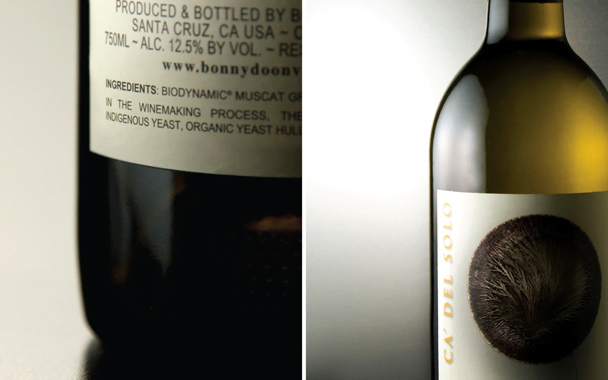I see a lot of wines in my line of business. But wines with ingredient labels is a first. The 2007 Ca’ del Solo Muscat and Albariño—produced by wine iconoclast Randall Grahm at Bonny Doon Vineyards—are just hitting the shelves, sporting labels that read: “Ingredients: grapes, sulfur dioxide.” Another line lists ingredients used during winemaking: “Indigenous yeast, organic yeast hulls, bentonite, cream of tartar.”
You’d think wine wouldn’t need ingredient labels beyond a line about what grape varieties went into it, if it didn’t already trumpet it on the front label. But the uncomfortable truth is that, in the interest of producing consistent, attention-getting, high-scoring wines, vintners commonly use all sorts of additives. And they don’t have to tell anyone about it—at least not in the U.S. (Other wine-producing countries, including Australia and New Zealand, require wineries to disclose any potential allergens—for instance, egg whites or milk products, common fining agents—used in winemaking.)
In addition to grapes, winemakers may add sugar to bolster the wine’s alcoholic strength; or they may stir in citric, malic, or tartaric acid and tannin to give the wine backbone. They might steep it with oak dust to approximate the vanilla and spice flavors lent by aging in oak barrels; or they might plump up its color and texture with the bluntly named Mega Purple, or other intensely sweet, deeply colored grape extracts. Troubled by weak fermentations? Add some enzymes or nutritional supplements to kick it up. Worried your wines might have unsettling, unique flavors—like minerals, earth, or that old-fashioned goût de terroir? Use laboratory-cultured yeasts instead of the ones already living on your grape skins. You can even pick yeasts and enzymes that help accent particular flavors.
In the end, only trace amounts of these additives remain in the wine, and none of them are harmful to your health in such miniscule amounts. But if you find that one of the great pleasures of wine is its ability to evoke the time, place, and person that made it—those little idiosyncrasies that make wine so different from year to year, vineyard to vineyard, producer to producer—then you want wine that’s made with as little interference as possible.
This is the thing: Consistency can make for good wine, but it doesn’t make for interesting wine. What’s compelling is to taste a wine that reflects the elements. A wine may taste like it gorged on the sun and warm temperatures, growing plump and lush, or like it shivered in cool rains, with ethereal fruit flavors barely covering a lean, nervy structure. It may feel like it grew out of cold, hard stone, or luxuriated in warm, dark earth. It might well theoretically taste better with a little more acidity, a little less alcohol, a dash of vanilla from oak, or a dollop of pineapple from special yeasts. But if everyone adjusts his wines for some Platonic ideal, we’ll have a sea of nondescript good wine—which is pretty much where we’re at. That’s what wine critics talk about as “internationally styled wine,” meaning it could have come from anywhere, including the inside of a factory.
How to find wines that aren’t cosmetically enhanced, plumped into a purple gob of fruit or mucked up with sugar, oak dust, and tannin additives? One way would be to find out what went into the wine. Ingredient labeling sure would make that easier.



 Pinterest
Pinterest


